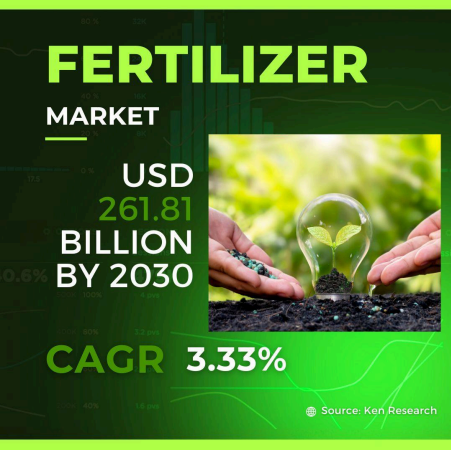Forget gold rushes, the future of agriculture lies in fertilizer. This multi-billion dollar industry is projected to explode, but can it sustain its growth? This blog breaks down the key drivers, regional variations, and challenges shaping the fertilizer market. Whether you’re a startup founder, a seasoned business leader, or an investor, this analysis will equip you with the insights you need to navigate this dynamic landscape. Let’s dig in.
Market Size and Growth: A Lucrative Opportunity, But Can it Sustain?
The global fertilizer market is a multi-billion dollar opportunity, projected to reach a staggering USD 261.81 billion by 2030, with a Compound Annual Growth Rate (CAGR) of roughly 3.33% (Ken Research). This robust growth presents significant opportunities for companies across the value chain. However, a shadow of controversy looms: can this growth be sustained in the face of environmental concerns and rising geopolitical tensions?
Key Drivers Fueling Growth and Potential Disruption
Several key factors are driving growth in the global fertilizer market, but also hold the potential for disruption:
- Rising Global Population: A growing populace necessitates increased food production, translating to higher demand for fertilizers to enhance crop yields. However, concerns about resource depletion and food security are putting pressure on sustainable practices.
- Shifting Dietary Patterns: The growing preference for meat-based diets, particularly in developing economies, creates significant demand for grains used in animal feed, further driving fertilizer consumption. This trend, however, raises ethical questions about animal agriculture’s environmental impact.
- Depleted Soil Fertility: Intensive agricultural practices can deplete essential soil nutrients over time, making fertilizers crucial for replenishing these elements and maintaining soil health. But excessive fertilizer use can also contribute to environmental pollution and water contamination.
Market Segmentation: Diverse Products for Diverse Markets and Competition
The fertilizer market caters to a variety of needs through distinct product categories, each with its own competitive landscape:
- Nitrogenous Fertilizers: These fertilizers provide nitrogen, a critical element for plant growth, and account for the largest market share by volume. Major players include Yara International (Norway), CF Industries Holdings, Inc. (USA), and Nutrien Ltd. (Canada). Consider partnering with or competing against these established companies in this high-demand segment, but be prepared for a fight – a recent price war between major producers has shaken the market.
- Phosphatic Fertilizers: Phosphorus is another crucial nutrient, and this segment is expected to witness significant growth due to its role in root development and crop maturity. Key players include The Mosaic Company (USA), OCP Group (Morocco), and EuroChem Group AG (Switzerland). Evaluate the feasibility of
entering this high-growth segment or explore strategic partnerships within it, but be aware of the environmental concerns surrounding phosphate mining.
- Potassic Fertilizers: Potassium plays a vital role in plant health and stress tolerance. This segment is dominated by companies like BHP Group (Australia), PotashCorp (Canada), and Israel Chemicals Ltd. (Israel). Analyse the competitive landscape and identify potential opportunities for collaboration or market disruption in this segment, while keeping an eye on potential resource nationalism policies impacting potash production.
Global Landscape: Regional Variations in Growth and Consumption
The global fertilizer sector exhibits regional variations in terms of growth and consumption patterns, offering distinct business opportunities based on location, but also presenting geopolitical risks:
- Asia Pacific: This region leads the global fertilizer market, driven by factors like increasing population, rising disposable income, and government initiatives promoting agricultural productivity. China and India are the key players in this region. Consider establishing a presence or forging partnerships in this high-growth market, but be mindful of potential trade tensions and evolving regulations.
- North America: A mature market with high fertilizer consumption, North America is focusing on developing sustainable and efficient fertilizer application methods. This presents an opportunity to develop and introduce innovative fertilizer technologies in this region, but be prepared to navigate a complex regulatory environment.
- Europe: The European fertilizer market is experiencing moderate growth, with an emphasis on environmental regulations and controlled-release fertilizers. This presents a business opportunity to develop and market eco-friendly fertilizer solutions in this region, but keep an eye on potential policy changes driven by the Green Deal initiative.
- Latin America: This region is expected to witness significant growth in fertilizer consumption due to expanding agricultural production. Consider exploring market entry strategies or identifying local partners in this high-potential market, but be aware of potential political instability in some regions.
The Distribution Network: Key Players and Considerations (and the Rise of Direct-to-Farm)
Fertilizers reach farmers through a complex distribution network, each level presenting potential business opportunities, but also facing disruption from the rise of direct-to-farm models. Ag-tech startups are leveraging digital platforms to connect directly with farmers, potentially bypassing traditional distributors and offering more targeted solutions.
- Manufacturers: Companies like those mentioned earlier produce fertilizers in bulk quantities. This segment offers opportunities for establishing manufacturing facilities
in strategic locations or partnering with existing producers, but also necessitates a focus on innovation and adaptability to cater to evolving market demands. ● Importers & Exporters: These entities facilitate international fertilizer trade, ensuring smooth flow of these products across borders. Consider offering logistics and trade facilitation services, or explore import/export opportunities in specific regions, while navigating potential trade barriers and geopolitical disruptions. ● Distributors: Wholesale and retail distributors act as intermediaries, making fertilizers accessible to farmers at regional and local levels. This segment offers opportunities for setting up distribution networks, partnering with existing distributors, or establishing a direct-to-farm sales strategy, but be prepared to compete with the growing trend of online marketplaces.
- Retailers: Agro-dealers and retail outlets sell fertilizers directly to farmers. Consider establishing a network of agricultural retailers or partnering with existing ones to reach farmers effectively, but be aware of the potential decline in foot traffic as farmers shift towards online options.
Market Trends: Shaping the Future of the Fertilizer Business
Several key trends are shaping the future of the fertilizer market, presenting both challenges and opportunities:
- Precision Farming: The adoption of precision farming techniques allows for targeted application of fertilizers, maximising efficiency and minimising environmental impact. Companies developing and offering precision farming solutions like smart sensors and data analytics stand to gain significant traction.
- Focus on Sustainability: Environmental concerns are driving the development of slow-release and organic fertilizers that minimise environmental damage. Companies focusing on biofertilizers, nutrient recycling technologies, and other sustainable solutions will be well-positioned for future growth.
- Government Regulations: Governments around the world are implementing stricter regulations to control the use of fertilizers and promote sustainable practices. Companies that can demonstrate compliance and develop compliant fertilizer formulations will have a competitive edge.
A Collaborative Effort for a Sustainable Future
The future of the fertilizer market hinges on a collaborative effort between industry players, governments, and research institutions. By embracing innovation, prioritising sustainability, and developing responsible business practices, the fertilizer industry can ensure food security for a growing population while safeguarding the environment for generations to come. This is not just about profit margins; it’s about feeding the world responsibly.

